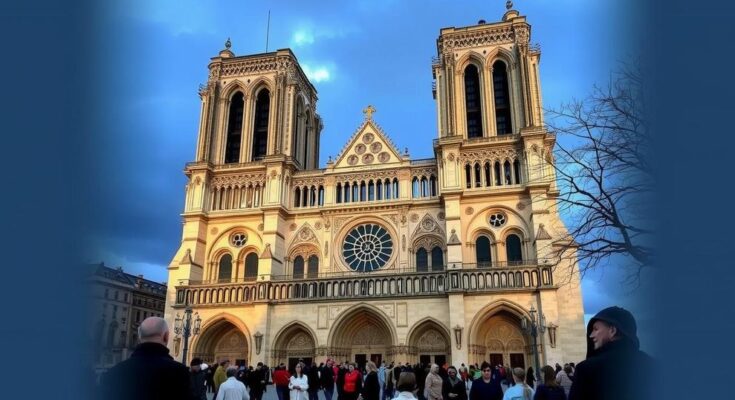Notre Dame Cathedral in Paris is set to reopen on Saturday after extensive repairs following its 2019 fire, with incoming U.S. President Donald Trump attending the ceremony. Approximately 50 heads of state are expected as the event symbolizes the restoration of this cultural landmark and the strengthening of international relations. President Macron will address attendees, and a concert featuring international performances is planned to mark the occasion.
On Saturday, Notre Dame Cathedral in Paris will reopen with the attendance of Donald Trump, the incoming U.S. President. This event marks a significant restoration of the iconic Gothic structure, nearly five years after it suffered substantial damage from a fire in April 2019. French President Emmanuel Macron extended the invitation to Mr. Trump, who confirmed his attendance on his Truth Social platform, commending Macron for overseeing the cathedral’s restoration. The reopening ceremony is anticipated to attract various world leaders, as they seek to strengthen diplomatic relations ahead of Trump’s inaugural inauguration on January 20, 2025.
The reopening ceremony blends public celebration with elements of politics, diplomacy, and religion. President Macron is set to deliver a speech before an audience of approximately 3,000 guests, with the event expected to host around 50 heads of state. Notably, Pope Francis will not attend due to his prior commitments in Corsica. Following the speeches, dignitaries will inspect the renovated monument and hear the restored Grand Organ, which is notable for being the largest in France with nearly 8,000 pipes, while a public concert is scheduled to enhance the festivities.
The restoration effort involved over 250 companies and numerous experts, culminating in a financial investment of approximately €700 million ($750 million). In a prior visit, Macron expressed gratitude to the craftsmen for their incredible efforts in restoring Notre Dame, reflecting on the historic and cultural significance of the achievement. The reopening ceremony is marked by heightened security, with around 6,000 police officers deployed to ensure the safety of attendees, underscoring the high-profile nature of this national event. The return of Notre Dame not only signifies its architectural revival but also represents a moment of resilience for France following a traumatic historical event.
Notre Dame Cathedral, an emblematic symbol of French heritage, suffered a catastrophic fire on April 15, 2019, resulting in significant structural damage, including the collapse of its spire. The incident elicited a profound sense of loss, with many viewing the flames as a dire omen for cultural heritage and Western civilization as a whole. In response, an extensive restoration project was initiated, enlisting hundreds of experts from various fields and costing approximately €700 million. This long-awaited reopening event marks a pivotal moment in the cathedral’s history, symbolizing both national pride and resilience.
The reopening of Notre Dame Cathedral on Saturday, with the presence of Donald Trump, underscores not only the successful restoration of a national treasure but also highlights the intertwining of politics and culture in contemporary events. The anticipated attendance of global leaders reflects the significance of this occasion, as it seeks to reaffirm France’s cultural heritage and political diplomacy. Ultimately, this ceremony will stand as a testament to collaborative efforts in the face of adversity, celebrating the revitalization of a monument that has long stood at the heart of Parisian identity.
Original Source: www.jordantimes.com




